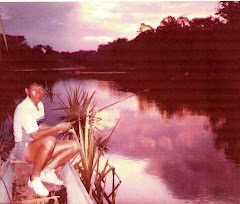+Malacca+1st+platoon+Sarawak+Rangers+attached+to+the+Manchester+Regt.JPG) The 1st Experimental platoon Sarawak Rangers (the para-military Iban Trackers trained and reformed into Sarawak Rangers, which made them into full-fledged soldiers). Kpl Adrian ak. Tandang (seated extreme right was killed in a battle with the CTs on 27 January 1953). They were trained in Segenting Camp, Port Dickson.
The 1st Experimental platoon Sarawak Rangers (the para-military Iban Trackers trained and reformed into Sarawak Rangers, which made them into full-fledged soldiers). Kpl Adrian ak. Tandang (seated extreme right was killed in a battle with the CTs on 27 January 1953). They were trained in Segenting Camp, Port Dickson.  The 2nd Experimental platoon, Sarawak Rangers. By the time Sarawak Rangers was disbanded on 15 September 1963, Sarawak Rangers had served with 42 British and Commonwealth Regiments. In the twelve years of fighting, their casualties were surprisingly low, considering that they were up front all the time. They suffered 20 KIA and 25 WIA. Taking into account that they were initially para-military (therefore enjoying less advantages and awards than regular soldiers), they had earned between them one George Cross (civilian equivalent of Victoria Cross), One George Medal, One Military Medal, One British Empire Medal and 23 Mention-In-Despatches.
The 2nd Experimental platoon, Sarawak Rangers. By the time Sarawak Rangers was disbanded on 15 September 1963, Sarawak Rangers had served with 42 British and Commonwealth Regiments. In the twelve years of fighting, their casualties were surprisingly low, considering that they were up front all the time. They suffered 20 KIA and 25 WIA. Taking into account that they were initially para-military (therefore enjoying less advantages and awards than regular soldiers), they had earned between them one George Cross (civilian equivalent of Victoria Cross), One George Medal, One Military Medal, One British Empire Medal and 23 Mention-In-Despatches. Op Ngerapuh (renamed Ops Mai Pulai (Operation Bringing Home)) is on its final phase. The target date to bring home the remains of the twenty one Iban Trackers and Sarawak Rangers buried in Peninsula Malaysia and Singapore is 31 August 2010. A Sarawak State -level Committee has been formed to handle Ops Mai Pulai, headed by the Deputy State Secretary II, Datu Ose Murang. Its members are from Headquarters 1 Infantry Division, Sarawak Veterans Association, the Protocol Department, Sarawak Economic Development Corporation and the Chief Minister's Office. This is an appropriate and high-level committee who is empowered to make decisions and have the resources available on their hands. With this formation, my ad-hoc committee which I had formed in early 2009 is now dissolved. All matters are now at the hands of the State and Federal Committees. I have also washed my hands off any responsibility regards Ops Mai Pulai. Th following points have been decided: 1. The remains of the Iban Trackers and Sarawak Rangers will be buried in a cemetery located near to the present St Joseph's cemetery and the Sarawak Club and adjacent to the 2nd World War Heroes Memorial. The committee saw the site as suitable. 2. SEDC has been given the task of redeveloping the present Monument / Cenotaph at the Museum Garden to accomodate more facilities such as parade ground etc. 3. The target date to bring the remains home is set for 31 August 2010. Meanwhile ground works are being carried out by the various Federal sub-committees. Can they meet the target date? Let's keep our fingers crossed.
11 July 2011
I called one of the Sarawak State committee members and he told me the preparation of the reburial ground in Kuching, not far from the State Museum is in progress, He said it should be ready by 27 July 2011.
I can see that once it is ready, the Federal Committee in Kuala Lumpur will then begin the task of exhuming the remains, if any, and put them inside special boxes, to be transported to Kuching.
I have to document and record all these events for my own purpose and use. I don't know who are involved now as the officers and personnels are very mobile. Will find out.
12 July 2011
I have identified two officers involved in Op Mai Pulai.
I was told that the exhumation works will begin on 20 July 2011, including the 2 graves in Singapore. The remains will be flown to Kuching on 26 July 2011. The reburial will be done on 27 July 2011. I'm trying to get the Sarawak State Committee to sponsor my trip for the event - otherwise I'll have to make the trip on my own. I have to see the project that I had started in 2008 to the end.
I hope to witness the exhumation of the 4 graves in Taiping Christian Cemetery.







